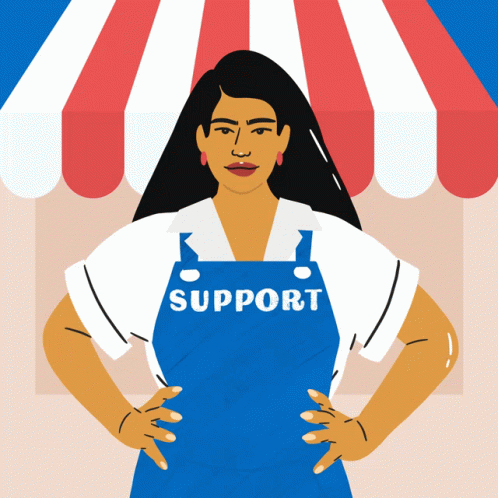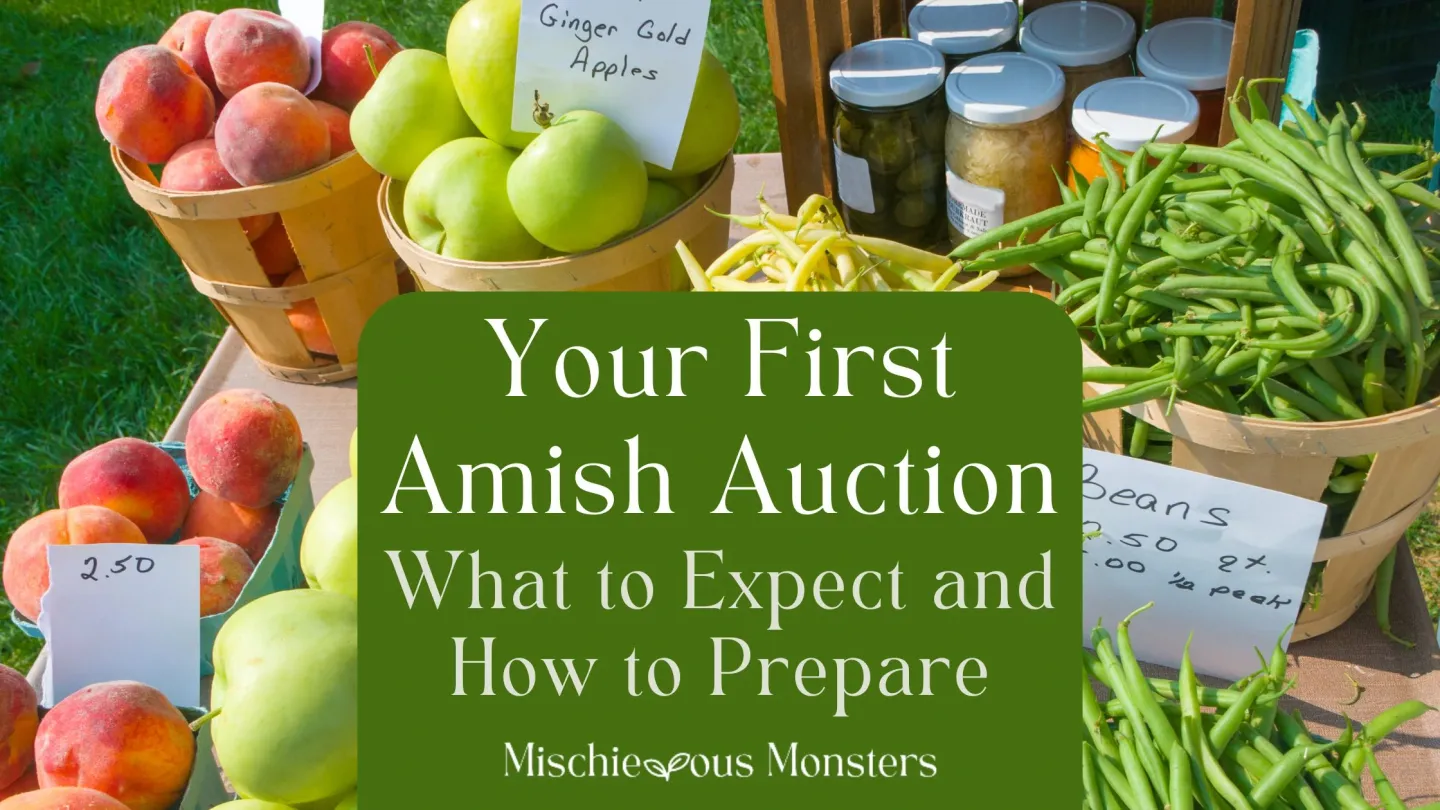
New to Amish Auctions?
Whether you're heading to a mud sale in Pennsylvania or a quilt auction in the Midwest, these gatherings are more than just shopping events. They're community traditions steeped in culture, craftsmanship, and old-fashioned charm.
In this guide, you'll learn:
- What to expect at your first Amish auction
- What to bring (and what to leave at home)
- How to show up with respect for the community's values
With a little prep, you'll be ready for a meaningful—and possibly muddy!—day filled with handcrafted goods, delicious local food, and a deeper appreciation for a different way of life.

1. Where Locals Shop
Supermarkets like Fareway and Hy-Vee often send buyers to these auctions, which means you can expect high-quality produce and locally favored items, sometimes even the same ones you'll later see on grocery store shelves.
These retailers know that Amish auctions are a reliable source of fresh, seasonal goods, so shopping alongside them can give you access to the best of the best before it's snapped up.

2. Cautious Driving
Watch out for people on foot and horse-drawn buggies sharing the road, especially as you get closer to the auction site. These rural roads aren't just for cars—families, children, and horses all use them, and right-of-way customs may differ from what you're used to.
Drive slowly, stay alert, and be prepared to stop at a moment's notice. Giving everyone plenty of space isn't just courteous. It's essential for safety.

3. Cash and Check Only
Amish auctions usually lack electricity or internet access, so modern conveniences like credit or debit card readers are unavailable. Most vendors operate on cash and checks only.
Be sure to bring enough cash to cover everything you might want to buy, from fresh produce to handmade goods. Some vendors may accept checks, but not all, so having a mix of small bills is your safest bet. ATMs can be scarce in rural areas, so plan to avoid any disappointment at the checkout table.

4. Avoid If You're On Call
Phone service at Amish auctions is often spotty or completely unavailable, thanks to the limited number of cell towers in these rural areas. Don't count on being able to call, text, or access the internet while you're there.
If you have responsibilities that require you to stay connected, like being on call for work or needing to check in with family, it might be best to skip the auction or make sure someone can cover for you. Think of it as a chance to unplug and soak in the experience, but only if your schedule allows it.

5. Plan Bathroom Breaks
Most Amish auction sites don't have indoor plumbing, so don't expect standard restrooms. You'l typically find outhouses or porta potties set up on the property—functional, but not exactly luxurious. These facilities can get crowded, especially during peak hours, and supplies like toilet paper and hand sanitizer may run low.
If you'd rather avoid the line (and the experience), it's a good idea to stop at a gas station or rest area on your way there and again on the way home. A little planning goes a long way when it comes to comfort.

6. Dress Modestly When Visiting Amish Areas
While you're not expected to match their dress, wearing modest, simple clothing shows consideration. Think covered shoulders, longer hemlines, and avoiding flashy prints when in their communities or attending public markets.
Also, opt for neutral or cool-colored clothing. Loud colors or bright outfits can make you stand out, which might attract unwanted attention.

7. Wear Boots or Old Shoes
They don't call them "mud sales" for nothing! Many Amish auctions are held in open fields or gravel lots, and spring weather often turns them into soggy, muddy playgrounds for boots. But mud isn't the only thing underfoot. You'll also be sharing space with horses, so don't be surprised if you step in a little… something extra. 🐴💩
Closed-toe shoes or waterproof boots are your best bet for staying comfortable (and relatively clean) throughout the day.

8. Bring Your Bid Number and Pen
To participate in the auction, you must register and get a bidder number, which is usually a simple process at the entrance or registration table. That number is your key to placing bids, so keep it handy and don't lose track of it.
It's also smart to bring a pen or pencil, a small notepad, or even a scrap of paper to jot down your number and keep a running list of your purchases. Things can move quickly, and having a record helps you stay organized when it's time to settle up at the end.

9. Bring a Big Vehicle and Trailer
It's easy to underestimate how much you'll bring home from an Amish auction. Between crates of produce, flats of flowers, handmade furniture, baked goods, and surprise finds you didn't plan on, but couldn't pass up, you'll likely leave with more than you expected.
That's part of the fun! If you're planning to shop big or even just browsing just in case, it's smart to come prepared with a larger vehicle, like an SUV and truck, or pull a trailer if you have one. If you prefer to rent a trailer, I recommend U-Haul or Home Depot. Fold-down seats, tarps, and bungee cords will also come in handy for packing up your items safely and securely.

10. Bring a Sack Lunch
Concession stands at Amish auctions tend to stick with traditional fare. Think pork sandwiches, hot dogs, and plenty of baked goods made with butter, milk, or eggs. Vegetarian and vegan options are usually scarce or nonexistent, so it's best not to rely on finding anything plant-based once you arrive.
Pack a satisfying plant-based lunch and some hearty snacks to keep your energy up for a long day of bidding and browsing. Sandwiches with hummus and veggies, fresh fruit, trail mix, roasted chickpeas, or homemade energy bars all travel well and help you stay fueled. Bonus points if you bring a thermos of iced tea or a reusable water bottle.
A little planning turns hunger into happiness and keeps your veganventure on track.

11. Set a Budget
With so many tempting finds, it's surprisingly easy to overspend at an Amish auction. That's why deciding on a spending limit before you arrive is smart.
Whether working with a strict budget or just wanting to keep impulse buys in check, having a clear number in mind helps you make thoughtful choices. You might even break your budget into categories—$40 for produce, $20 for baked goods, and $50 for home goods—so you don't spend everything at the first section.
Writing down your purchases as you go can also help you stay on track. Auctions are thrilling, but your wallet will thank you for a bit of pre-planning.

12. Research Market Prices
It helps to understand what similar items cost in regular stores before you head to the auction. Knowing typical prices for produce, baked goods, or crafts gives you a useful benchmark—and helps you set a realistic maximum price you're willing to pay.
Auctions can get competitive, and getting caught up in the excitement is easy. Considering those store prices helps you recognize a good deal and avoid overpaying. Plus, comparing quality and value is much simpler when you're bidding.

13. Divide and Conquer
At larger Amish auctions, it's common to find multiple auctioneers running different sales simultaneously across several areas. This means a lot is happening at the same time, and you might miss out on great deals if you try to follow everything solo.
If you're attending with friends or family, consider splitting up to cover more ground. Each person can focus on different auction rings or sections, increasing your chances of spotting bargains and unique items before someone else snaps them up. Stay in touch throughout the day to regroup, share updates, and compare notes on the best finds.
Teamwork turns the auction into a fun, strategic adventure, especially when you each have your very own walkie-talkie to talk to each other throughout the day.

14. Bulk Items Are Common
Some items are sold in bulk rather than by the single piece at Amish auctions. For example, you might see a whole pallet of watermelons or large bags containing 50 pounds of potatoes up for bid.
If you're interested in these deals, be prepared to take home larger quantities than you usually buy at the grocery store. This can be a great way to stock up and save money, but it also means you'll need enough space to transport and store your haul.
Think ahead about how much you can realistically handle, and whether you have the right vehicle and storage options at home. Bulk buying is perfect for those who love to preserve, share with friends, or meal prep in advance.

15. Multiple-Quantity Bids
At many Amish auctions, certain items are sold in multiples rather than individually. For example, you might see jars of pickles listed with a bid price multiplied by a set number, like 6 times the bid amount, meaning if you win the bid, you're committing to buy 6 jars in total.
Pay close attention to these details before you bid so you know precisely what quantity you're committing to and can budget accordingly. Buying in multiples can be a fantastic way to get great value on items you love, but it also means you'll want to be sure you have enough storage space and a plan for using or sharing the extra jars.

16. Plan Recipes Before Bidding
Before bidding on fresh produce, consider what you want to cook with it. For example, if you're eyeing Roma tomatoes, consider making homemade salsa, pasta sauce, or sun-dried tomatoes. A clear plan helps you avoid buying more than you can use and reduces food waste.
Plus, when you know what recipes you're aiming for, it's easier to decide how much of each item you need: a few pounds for a small batch of sauce or a larger haul for canning and freezing. Planning also helps you shop smarter and make the most of the great deals at the auction.

17. Share to Prevent Waste
If you have more produce or goods than you can use before they spoil, consider sharing the bounty with friends, family, or neighbors. It's a great way to spread the joy and avoid waste. For example, my dad tends to give away most of a pallet of pumpkins to families who will make jack-o'-lanterns with them later.
Another excellent option is donating surplus items to a local food bank or community pantry, where your extra fresh goods can help others in need. Many auctions foster a strong sense of community, and passing along what you can't use keeps that spirit alive while ensuring nothing goes to waste.
Planning to share or donate also frees up space at home and makes your auction haul feel even more rewarding.

18. Look for Smaller Bundles
In addition to bulk lots and large quantities, many Amish auctions also feature side tables where smaller amounts of produce are sold. Think of a single bunch of fresh asparagus, a few ears of corn, or even just a perfect tomato. These smaller lots are ideal if you buy just enough for a recipe or want to sample something new without committing to a large quantity.
Keep an eye out for these side tables as they offer great flexibility, especially if you're shopping solo like me or don't have room for bulk purchases. It's a nice way to grab fresh, seasonal ingredients in manageable amounts while enjoying the auction experience.

19. Seasonal Flowers and Produce
Auctions often have a farmer's market's lively, colorful atmosphere because they are bursting with seasonal fresh flowers, garden plants, and homegrown produce.
Beyond the bidding excitement, these gatherings showcase the best of local farming and craftsmanship: pots of sunflowers and daisies, fragrant herbs ready for your kitchen, and garden goods like seedlings. It's a sensory feast that celebrates the changing seasons and offers a chance to bring farm-fresh beauty and bounty into your home.
Spring Amish Auction Finds
- Seedlings and Garden Starters: Tomatoes, peppers, herbs, squash, and cucumbers
- Flower Baskets and Potted Blooms: Hanging petunias, geraniums, and pansies
- Early Produce: Asparagus, rhubarb, spring onions, and spinach
- Crafts and Quilts: Lightweight table runners and spring-themed patterns
- Tools and Supplies: Hand tools, gardening implements, and seed potatoes
Summer Amish Auction Finds
- Fresh Fruits: Watermelons, cantaloupe, peaches, berries, and sweet corn
- Canning Tomatoes and Cucumbers: Perfect for sauces, salsa, and pickling
- Homegrown Veggies: Zucchini, beans, peppers, eggplant, tomatoes, and new potatoes
- Outdoor Furniture: Handmade picnic tables, Adirondack gliders, porch swings, and birdhouses
- Woven Baskets: Ideal for produce, storage, or decor
Fall Amish Auction Finds
- Pumpkins and Gourds: Decorative and edible varieties in every shape and color
- Apples and Cider: Fresh apples (like Gala and Honeycrisp) plus homemade cider
- Hearty Vegetables: Cabbage, butternut squash, kabocha, and sweet potatoes
- Root Vegetables: Carrots, turnips, parsnips, rutabagas, kohlrabi, and beets
- Mums (Chrysanthemums): In rich autumn shades like gold, burgundy, orange, and white
- Ornamental Corn: Colorful, dried ears used for fall decorating; perfect for centerpieces, wreaths, and porch displays
- Preserved Goods: Jars of apple butter, pickled vegetables, and jams
- Fall Quilts: Heavier bed quilts with warm colors and fall motifs
- Wood Stoves and Firewood: Practical goods for winter prep

20. Listen Closely
Auctioneers are known for speaking quickly and clearly, often rattling off bids and item details rapidly. This is part of what keeps the auction exciting, but it can also catch newcomers off guard.
If you're not paying close attention, it's easy to accidentally place a bid on something more expensive or in larger quantities than you intended.
To avoid surprises, focus carefully on the auctioneer's words, watch the other bidders, and don't be shy about asking for clarification if you're unsure about what's being offered or how much you're committing to. Staying alert helps you bid confidently and keep your budget intact.

21. Auctioneer Lingo Explained
Understanding the unique language auctioneers use can make your bidding experience smoother and less confusing. Here are some common terms you'll often hear:
- "Half" means 50 cents. For example, if the auctioneer says "4 and a half," that means $4.50. It's a shorthand way to speed up bidding calls.
- "Quarter" means 25 cents. So "9 and a quarter" translates to $9.25. These fractions help auctioneers keep the pace moving without saying the full amount.
- "Half a pint" means one cup. This term usually comes up at concession stands, where portions might be measured using traditional volume terms.
Familiarizing yourself with these phrases before you go helps you understand bids instantly and avoid mistakes when placing your own. It's all part of the fun and rhythm of the auction!

22. Don't Bid Too Soon
Before placing your bid, it's often wise to pause and watch how the auctioneer manages the price.
Sometimes, if there's little immediate interest, the auctioneer may lower the starting price or give a chance for others to jump in. Waiting a moment can help you avoid overpaying and give you a better sense of the competition.
Just be careful not to wait too long. If someone else bids, the price can quickly rise. Paying attention to the auctioneer's rhythm and the crowd's reactions can turn your patience into a savvy saving.

23. Eye Contact Means Bidding
At auctions, eye contact with the auctioneer or their helpers can be interpreted as a sign that you want to place a bid. If you're browsing or thinking about your next move, avoiding locking eyes with them is best to prevent accidentally signaling interest.
Auctioneers are trained to watch for bidders' subtle cues, so even a glance can sometimes trigger a call for a bid. If you want to bid, make clear, confident eye contact or raise your hand to ensure your intention is unmistakable. Being mindful of where you look helps you control your bids and avoid unintended purchases.

24. Showing Your Number Means You're Bidding
To place a bid at an auction, raise your bidder number high and ensure it's visible to the auctioneer. Holding it up confidently signals your interest in the item up for sale.
Avoid waving it wildly or flapping it around too much—steady and deliberate is the way to go. This helps the auctioneer see your bid quickly and keeps the process moving smoothly. If you're new, practicing this ahead of time can help you feel more comfortable when the bidding starts.

25. Auctioneer Helpers' Vocal Cues
At Amish auctions, auctioneer helpers often chime in with vocal sounds to keep the energy high and signal what's happening during the bidding. Sounds like "oh" or "whoa" aren't just random noises. They're cues that a bidding war is underway.
When you hear these excited calls, multiple bidders compete for the same item, which often increases the price. These vocal cues help everyone stay tuned to the excitement and encourage more bids. Listening for them can alert you that a popular or valuable item is on the block, so you can decide whether to jump in or hold back.

26. Confirming Bids
During the auction, the auctioneer will often point directly at bidders to confirm that they're still in the running for an item. This quick gesture is a way to make sure you’re actively interested and ready to continue bidding.
- If the auctioneer points to you and you want to keep bidding, raise your number again or make a clear signal.
- If you're no longer interested, holding back or lowering your hand to indicate you're dropping out is perfectly fine.
Paying close attention to the auctioneer's pointing helps you avoid confusion or accidentally staying in the bid longer than you want. It's all part of the fast-paced rhythm that keeps the auction smoothly.

27. Nods and Shakes
Bidding often moves quickly at an Amish auction, and auctioneers rely on clear, nonverbal cues to keep the process smooth.
- A nod of your head typically means you're still interested and want to keep bidding on the current item. It's a quick, straightforward way to confirm participation without raising your number again.
- Conversely, a shake of the head signals that you're done bidding and are dropping out of the competition for that item. This helps the auctioneer know when to move on or when the bidding ends.
Being comfortable with these simple gestures can help you stay engaged in the fast-paced auction environment and avoid accidentally staying in a bid longer than you want. Watching other bidders for these cues can also give you a better sense of when the bidding might wrap up.

28. Sold!
When the auctioneer says the word sold, it signals the official end of bidding for that particular item.
The highest bidder has won the item and is expected to pay the agreed price. No further bids are accepted after that, so staying alert and knowing when to raise your number or step back is essential. This clear verbal cue helps keep the auction organized and moving smoothly, marking each sale's successful conclusion.

29. Show Your Number to Claim Items
Once you've won an item at the auction, you must show your bidder number to claim your purchase. This helps the sellers and auction staff easily identify who pays and picks up the item.
Hold your number up clearly and promptly when it's time to collect, so the process goes smoothly and you avoid any mix-ups. Keeping your number handy throughout the auction makes it easier to move through checkout and ensures you get all your treasures without hassle.

30. Keep Track of Your Purchases
At Amish auctions, things move quickly, and it's often a cash-or-check system without digital receipts. That's why it's so important to write down everything you win and the price you paid. Whether it's a flat of strawberries, a handmade bench, or a dozen jars of jam, keeping a simple list helps you stay organized and avoid confusion at checkout.
Bring a small notebook or clipboard and jot down each item, the final bid amount, and any notes. This is especially helpful if you bid in multiple places or send someone to bid on your behalf. With your list in hand, checkout is faster, more accurate, and less stressful.

31. Pay Before You Leave
Before heading home with your auction finds, pay for all your items at the designated checkout area. At Amish auctions, payment is typically made at a central table or tent, and most accept only cash or check. That means no credit or debit cards. So that you know, having your list of purchases ready and your bidder number handy will speed up the process and help avoid confusion.
It's essential to settle up before leaving the auction grounds—not just out of courtesy, but because it's often a small, community-run event where honesty and trust matter. Once you've paid, you can load up your items and head out.

32. Claiming Larger Items
At Amish auctions, smaller items—like baked goods, canned preserves, or small bundles of produce—are often handed to you right after you win the bid. But for larger items, such as furniture, pallets of produce, or heavy equipment, you'll typically receive a claim ticket instead.
This ticket is proof of purchase and includes details like your bidder number and the item description. You'll present it when you're ready to pick up your item at a designated loading area or directly from the seller. Keep your claim tickets safe and organized—losing one can make pickup tricky. It's also good to ask where and when to load your larger items, as some areas may require staff assistance or special instructions.

33. Double-Check Your Tickets
When you win a larger item at an Amish auction, your claim ticket, usually written by hand, typically has two numbers: one for the seller and one for the buyer (that's you). It's important to double-check that your bidder number is correct on the ticket before walking away. One way to tell is that the seller and buyer numbers tend to be written in different-colored pens or markers.
Mistakes can happen in the hustle of the auction, and verifying your number on the spot helps prevent confusion, delays at pickup, or accidentally walking off with someone else's item. A glance now can save a big headache later, especially when multiple bidders are winning similar-looking items.

34. Support Amish Businesses
Before heading home, stop by Amish-run businesses nearby to shop and support the community.
- Baked Goods Shops
Many Amish bakeries offer bread, rolls, and sometimes vegan-friendly baked treats made without eggs or dairy—think hearty rye bread or soft pretzel-style bread. - Herbal and Natural Remedies Shops
Amish herbalists often craft plant-based tinctures, salves, and teas made from local herbs—perfect for natural wellness and self-care. - Amish Craft and Textile Shops
While not food-related, these shops offer handmade baskets and reusable cloth products, which are great for sustainable shopping and gifting. - Maple Syrup Producers
Look for pure, locally tapped maple syrup—a vegan-friendly sweetener perfect for pancakes, desserts, or drinks. - Discount Bulk Stores
Some Amish communities run bulk stores offering great prices on grains, beans, nuts, dried fruits, and spices—perfect for stocking up on pantry essentials. - Greenhouses and Plant Nurseries
Amish-run greenhouses grow seasonal vegetables, herbs, and flowers, ideal for finding fresh plants or starting a garden.

35. Don't Outwardly Complain or Protest Their Horse-Drawn Buggies
While they may slow traffic, horse-drawn buggies are central to Amish life and values. Expressing frustration—especially in earshot—can be rude or dismissive. Instead, take a breath, slow down, and remember you're witnessing a unique way of life that prioritizes simplicity over speed.
If you follow a vegan lifestyle, it's understandable to feel conflicted about the use of animals for transportation. However, in Amish communities, horse-drawn buggies are a core part of their tradition and a conscious alternative to modern technologies, not a sign of cruelty or neglect.
Protesting or voicing discomfort in their presence may come off as disrespectful and counterproductive. Instead, use this moment to practice quiet compassion for the animals and people living by different values. You can still advocate for animal rights in ways that honor kindness and cultural sensitivity by keeping your opinions to yourself.

35. Accept the Amish as They Are
When attending an Amish auction, you're stepping into a community with values, traditions, and a way of life that may differ significantly from yours. It's important to approach the experience with respect, humility, and an open mind. Whether it's their simple clothing, use of horse-drawn buggies, or avoidance of modern technology, remember: it's not your role to question, critique, or try to modernize their choices.
The Amish are welcoming and generous hosts, but they also value privacy and modesty. Treat their customs with dignity, even if you're curious. Kindness means recognizing that their lifestyle is not up for debate. Acceptance, rather than commentary, builds bridges—and shows genuine appreciation for being invited into their space, even for just a day.

36. Some of Their Terms Are Old-Fashioned (Like "Englishmen" or "English" for Non-Amish Individuals)
If someone at the auction refers to you as "English" or an "Englishman," don't be surprised—and don't take offense.
In Amish culture, "English" is their term for anyone who isn't Amish, regardless of background, language, or heritage. It's not a comment on your nationality or a personal label. It's a cultural shorthand that dates back to when the Amish first settled in America and distinguished themselves from the broader, English-speaking society.
These terms reflect the Amish community's historical lens and way of relating to the world outside their own. So if you hear them, smile and do not take it as a judgment. It's just how they've always described outsiders. Understanding these little quirks of language can make the experience feel even more authentic and enriching.

37. Avoid Taking Photos of Amish People
Photography is generally discouraged in Amish communities, especially when capturing images of people. Many Amish avoid being photographed out of deeply held religious beliefs and a commitment to humility, as they view posed or direct pictures as a form of vanity or self-promotion. Even casual or candid photos can feel invasive and disrespectful.
If you're in a scenic area and want to take pictures of the surroundings—barns, landscapes, horses, or auction scenes—just be mindful of who might be in the background. When in doubt, it's always best to ask a local or event organizer what's considered appropriate. Respecting these boundaries not only honors their faith and values, but also shows appreciation for being welcomed into their space.
What You Can Usually Photograph
While photos of Amish people are off-limits out of respect for their beliefs, there are still plenty of beautiful, photo-worthy moments you can capture at an auction or in Amish country. Here are a few things that are generally acceptable to photograph:
- Produce displays: Colorful arrangements of fruits, vegetables, and baked goods
- Handmade furniture or crafts: As long as no people are prominently featured
- Scenic landscapes: Farms, barns, fields, and countryside views
- Auction tables or market setups: Just avoid snapping pictures of people nearby
When in doubt, a friendly ask—"Is it okay if I take a picture of this?"—goes a long way. Most people will appreciate the courtesy, and you'll leave with beautiful, respectful memories of the day.

39. Refrain from Gossip or Probing Questions
The Amish value privacy, humility, and respectful conversation. While it's natural to be curious about their way of life, asking direct or overly personal questions—especially about church practices, family rules, or individual choices—can feel intrusive or even offensive. Topics that might seem casual to outsiders, like why someone left the community or how their church is structured, are often considered private matters.
If you're having a conversation with an Amish person, let it unfold naturally. Take your cue from what they choose to share and resist the urge to dig deeper. Avoid gossip or speaking critically about others in the community—even jokingly—as this can be seen as disrespectful.
Genuine interest paired with humility builds trust and mutual respect, allowing for meaningful exchanges without crossing personal boundaries.

40. Support Their Work with Gratitude and Quiet Appreciation
When you purchase Amish-made goods—fresh-baked bread, beautifully stitched quilts, or finely crafted furniture—express your appreciation with genuine gratitude rather than grand gestures or overly sentimental praise. The Amish take great pride in their work but value humility and simplicity, so quiet respect goes much further than romanticizing or treating their labor like a novelty.
A sincere, heartfelt "thank you" acknowledges their skill and effort without putting them on a pedestal. This appreciation honors their values and fosters a positive connection, showing that you genuinely respect the care and craftsmanship behind each item.

Final Thoughts: Enjoy the Experience, Respect the Culture
Attending an Amish auction is more than just a chance to score handcrafted treasures or fresh produce—it's an opportunity to witness a way of life rooted in tradition, community, and simplicity. Whether you're vegan, curious about Amish culture, or love a good country sale, showing up with respect and openness goes a long way.
Embrace the slower pace, muddy boots, and friendly faces. Be mindful, ask questions gently, and enjoy the quiet moments between the action. And remember—sometimes the most rewarding part of the day isn't what you buy, but the experience itself.
Tread carefully and bid boldly. Until next time!
More Outdoor Activities




Summer Meal Prep




Gardening















